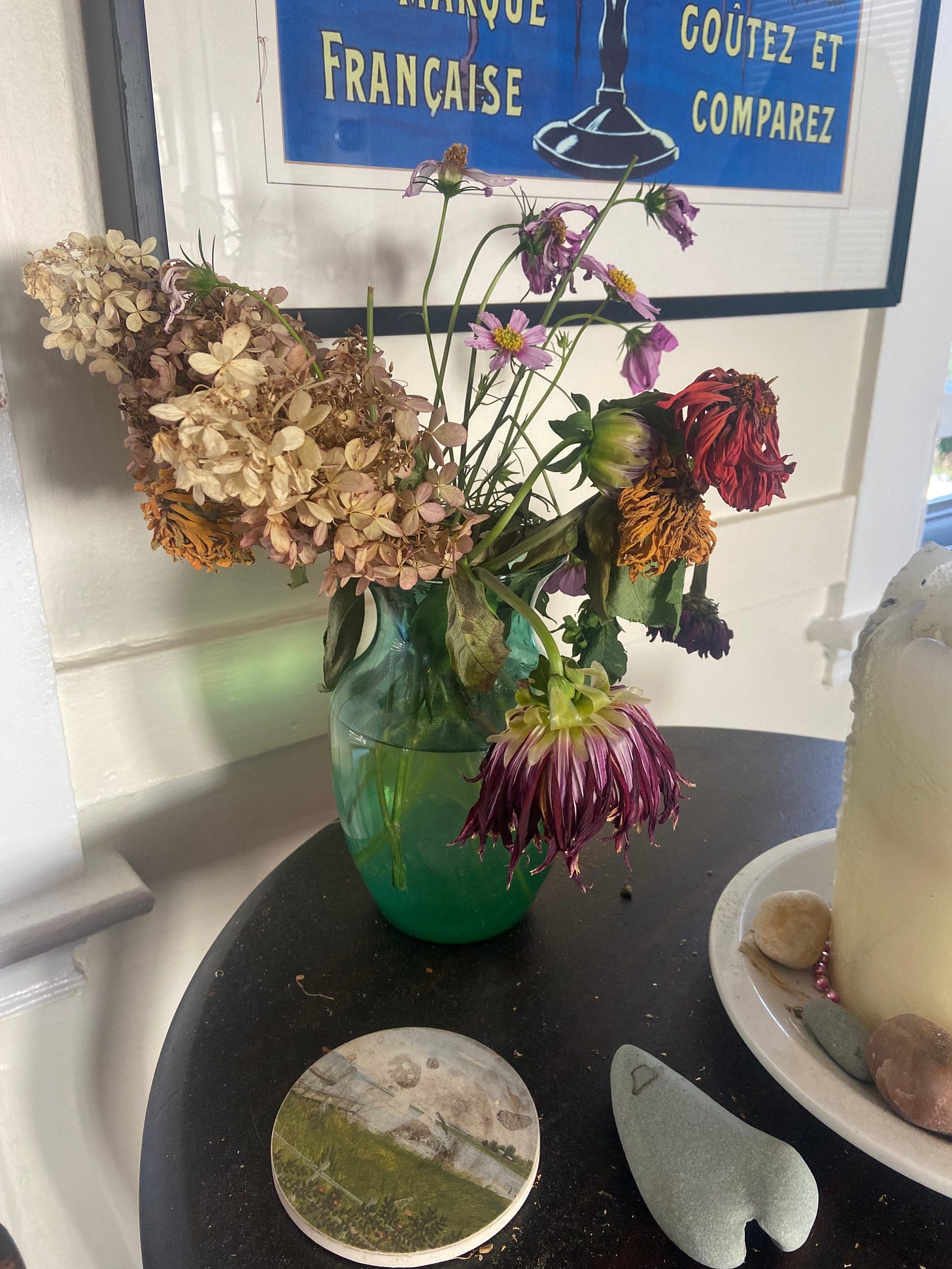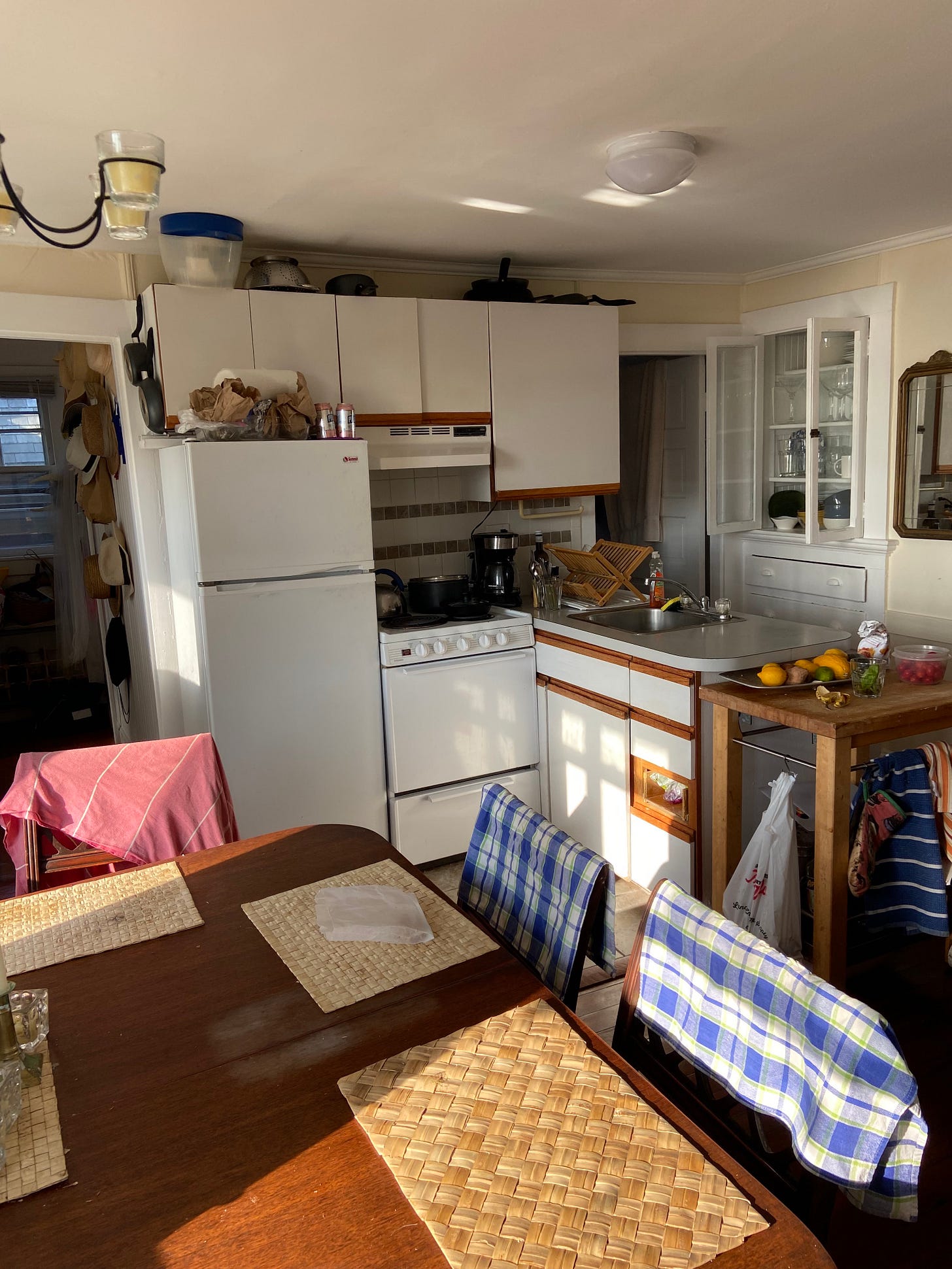My Eggplant, Hank's Tomatoes
Issue No. 10 | Hank | Recipe(ish): Eggplant Caponata | September Advice
This post is syndicated from the actual Occasional Tamarkin. I posted it here as an experiment when I was toying with the idea of publishing in two places. You can find my other posts (and subscribe) at www.davidtamarkin.com.
The room I rent in Provincetown has the gray industrial carpeting you’d find in an old Motel 6, but you don’t notice it much—somebody has thrown an old red rug over it. In one corner there’s a creaky chest of drawers; in the other, a mattress on a naked metal frame. The door opens to a living room, where there’s a couch I avoid (it’s usually somehow moist), and beyond that a large and sunny bathroom, which is littered with chest hairs (origin: unknown). I’m a shoes-off person when I’m in my or anybody else’s home, but in this apartment I tend to keep my shoes on, even in the shower.
My husband and I rent this room because it’s cheap (for Provincetown) and the views of the bay from the back windows are too good to give up. But we also rent it because it comes with a guy I'll call Hank, the apartment’s primary tenant. If you’ve spent any time in Provincetown, you might recognize him: He’s a cheerful bear of a man who can be identified by his tiny wireframe glasses, his bushy salt-and-pepper beard, and the fact that he often sings his words instead of speaks them. Hank is a choral director, an organist, and an expert on very old music; when he says “helloooooo” and “how are youuuuu,” he does so in a low, booming bass tone.
Rapture comes easily to him. Good weather, a Bach prelude, a handsome man on the street: they are all “gloooooorious!” The bread I bring him from King Arthur: “DIVINE.” Generally I’m skeptical of such overt positivity, but for Hank I make an exception. As an artist, a connector, a guy who aches as lasciviously for twinks as he does Poulenc, he personifies a dying spirit of Provincetown. He is, happily (but also sadly), the rare piece of evidence that that spirit still exists.
On my first night in town a few weeks ago, I leaned against the banister at Porch Bar and argued with a friend of Hank's about what makes him a great cook.
"It’s because he’s a gardener," I said.
“No, it’s because he’s scrappy,” the friend said. “He makes do with whatever he’s got.”
“Yes,” I said, “he can do that because he’s a gardener.”
What neither of us pointed to was Hank's ungodly kitchen. There, you’ll find a couple of dull knives; a few thin, battered pots; a plastic cutting board; a cast iron pan; and vestiges of the previous day’s (or week’s) meals. There are oil splatters on the electric stove, unidentifiable food particles stuck to the sink, and a soggy plastic bag of compost hanging from the handle of one of the drawers. Fruit flies everywhere. A single questionable kitchen towel. There’s a long history of great food coming out of kitchens like this; I’m reminded of Down and Out in Paris and London, and also the final Cormac McCarthy novel (“cant get a decent cheeseburger in a clean restaurant”). And I would be remiss if I didn’t mention that I baked maybe my best focaccia ever in this kitchen, mixing the dough in one of those battered pots with a soup spoon. But I don’t think the kitchen explains Hank's food. I’m sticking with the gardening theory.
Gardners respect the ingredients they grow. It’s not so much that they “make do” with whatever’s in the garden; it’s that they've put enough work into the ingredients already—why muck them up? On our first night in town, Hank took out some gnocchi he’d made from a bit of ricotta he’d found in the far reaches of the fridge. (The fridge is the scariest place in the apartment, and I willed myself not to think about what state the ricotta was in when he found it.) He paired it beautifully with corn, handfuls of cherry tomatoes, and lots of ripped basil, all of which he barely cooked. The tomatoes and basil came straight from the feral little farm he keeps alongside his driveway, where he casually grows sorrel, beans, mint, and chard. Before he left town for a few days, he pulled back some branches to show me where all the tomatoes were hidden. “They must be USEDDDDDDDDDD!” he sang.
I used them in a way I think he would have liked: I made caponata. A simple dish, but if you get it right, it sings.
A Rough Recipe for Eggplant Caponata
For years I’ve used Steven Satterfield’s recipe for caponata, which is in his excellent first book, Root to Leaf. This recipe is based on that one, but reflects some tweaks I’ve made over the years. I keep the ingredient amounts purposefully loose here, because I believe caponata is one of those rare recipes where you really can improvise. You just have to nail the seasoning at the end.
Start with one large eggplant and cut it into cubes. Toss with enough olive oil to coat it, season with salt, and roast in a 350-degree oven until the cubes are golden-brown and creamy. This takes an annoying amount of time, upwards of 45 minutes. You can also do this on the stovetop, frying the eggplant in olive oil over medium heat, but you have to do it in batches, so I don’t think it’s much of a time-saver. (In both cases, salting the eggplant and letting it sit for 15-30 minutes will help it brown, but I usually skip this step.) Get the eggplant as creamy as possible without it collapsing and losing its shape, then set it aside.
Make a tomato sauce: heat a few tablespoons of olive oil in a large skillet over medium heat and sauté 1 diced yellow onion, a few thinly-sliced garlic cloves, and a few pinches of crushed red pepper flakes. When the onion has softened, add a few fistfuls of sliced cherry tomatoes. I love Sungolds for this, but any small tomato will work. You can also dice some large tomatoes, but my hot take is that smaller tomatoes are always better than large ones. Add ¼ cup or so of golden raisins, a couple tablespoons sherry vinegar, and 2 teaspoons or so honey. If you want to add a spoonful of capers or chopped olives, do that now. Season the sauce with salt.
Let the sauce cook for a short period of time, until the tomatoes just start to break down. Add the eggplant to the skillet (or, if the skillet isn’t big enough, toss everything together in a big bowl) and start tasting. This is the most important step of making caponata: you’re going to taste, adjust the salt/vinegar/honey, and taste again. Keep going until you’ve reached a perfect balance of sweet, tart, and salty. Let the caponata hang out for an hour or so if you can, then serve it on toast, on polenta, on pasta, alongside some fish, or just on its own.
September Advice
Eat something by Kelly Fields. A few summers ago I saw chef Kelly Fields in a restaurant and essentially asked for her autograph. I'm a fanboy! And now, after eating at her Provincetown restaurant Butch's, I feel so justified in my adoration (her fig tart is the best thing I've eaten in months). If you can't get to Butch's, make the pumpkin bread from her cookbook (but message me or leave a comment here first so I can warn you about the critical typo in that recipe; it makes a big difference).
Read Entitlement by Rumaan Alam. I read a very early draft of this book and I can tell you that it is somehow even more wild than Leave the World Behind. As always with Rumaan, my favorite scenes are the ones in which seemingly nothing happens (but don’t worry, a lot happens in this book). It comes out on Tuesday but I think you should pre-order it, or reserve it from your library, now.
Switch allegiances to Deep River chips. I know, I know, you love Cape Cod chips. Or maybe you're in my Cincinnati crew and you love Grippo's. Fair! I love those chips, too. But this summer I finally admitted that Deep River is just better (particularly the rosemary and olive oil flavor), and I broke up with all the other chips in my life. I believe this is inevitable for all of us; make the switch now and have less regrets later.
Think critically about All Fours. Miranda July is a singular artist and thinker and this book is really fun and impactful and original but come on, people—don't just gush. To really respect a piece of art you've got to acknowledge how it succeeds as well as how it fails. And this book does drag a bit in parts...
Buy your fall tea. As I type this I’m sitting outside in Chicago, where it’s 80 degrees and just slightly humid. But this weather is a tease—the cooler nights and days are right around the corner. To me that means afternoon cups of tea. I highly recommend the black snail tea from The Little Red Cup Tea Company in Portland, ME.
Make Sarah Jampel's 50/50 Tortillas, which are half corn, half wheat, and maybe the easiest tortilla dough you'll ever worked with.







